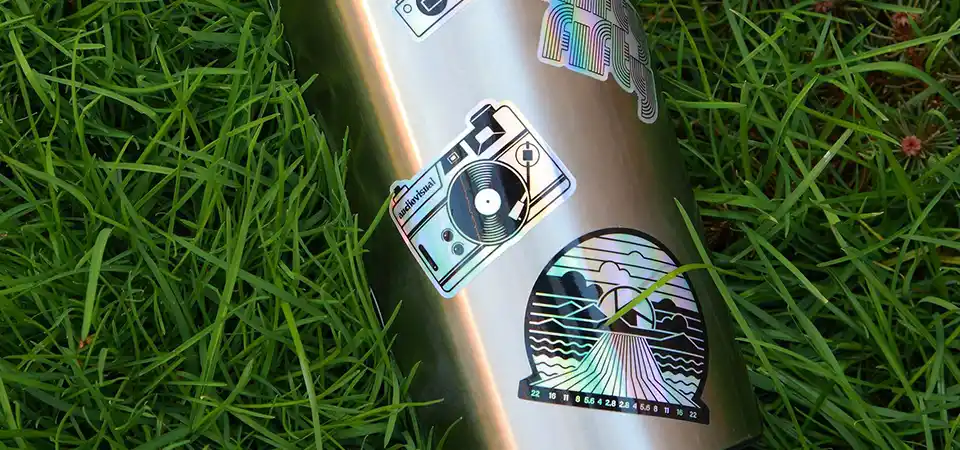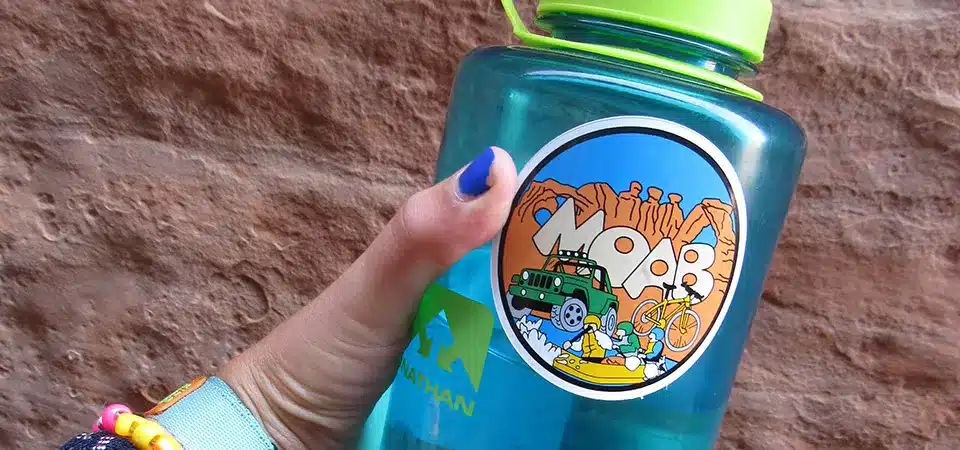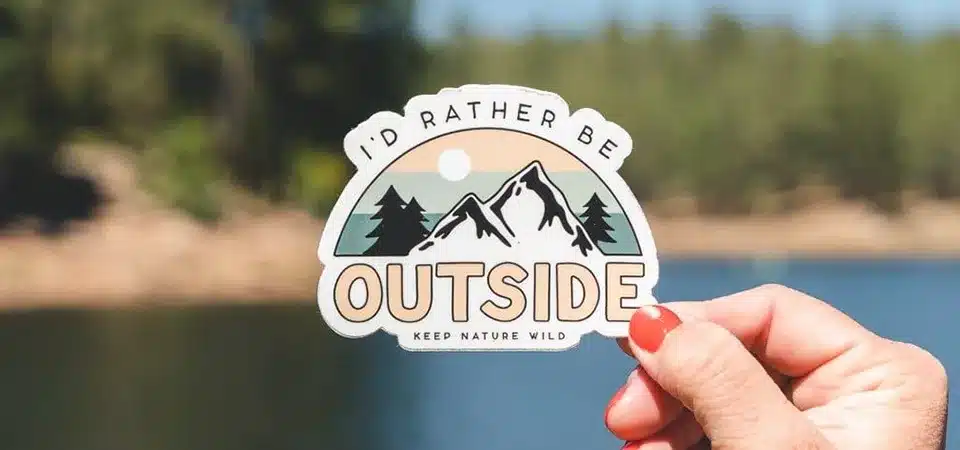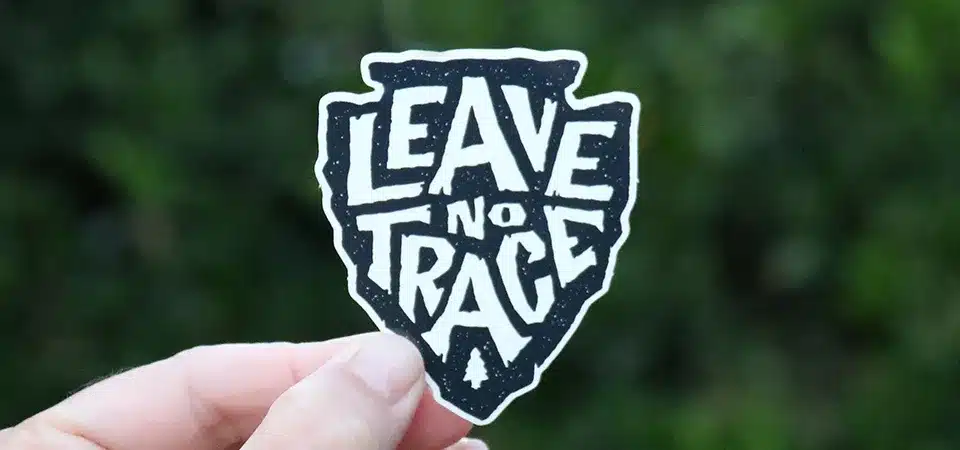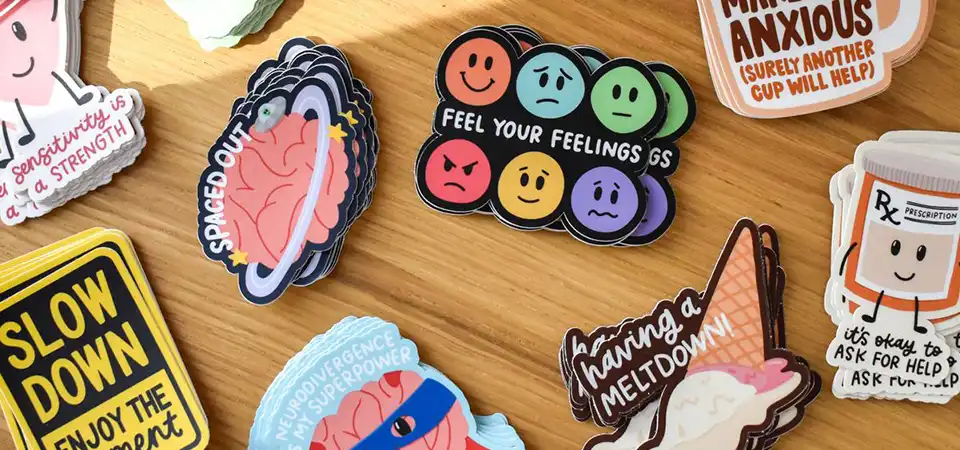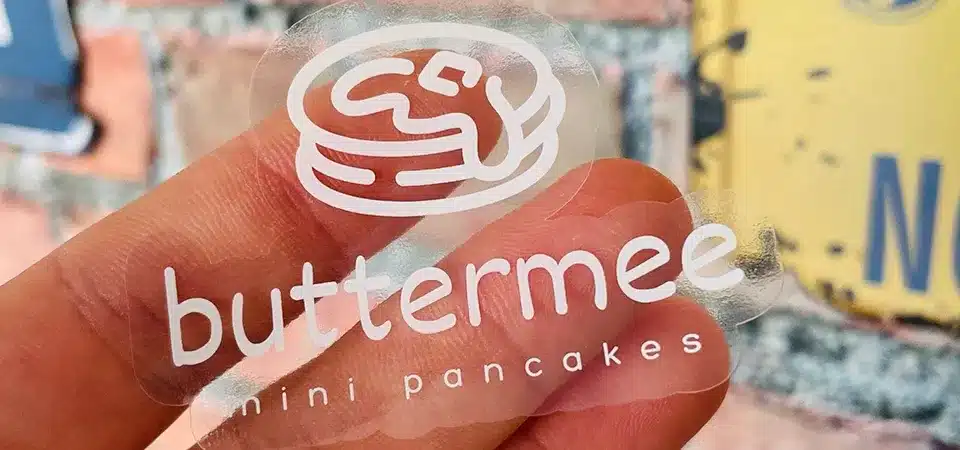You placed a beautiful new sticker on your water bottle, but after one wash, it’s a peeling, inky mess. It's frustrating when stickers don't last, wasting your money.
As a sticker expert, I can tell you that vinyl is naturally water-resistant, but not always 100% waterproof. True waterproofing depends on the ink and a protective finish. For a sticker to survive washing or rain, it needs waterproof ink and a laminate layer.
People often think "vinyl" automatically means a sticker can survive anything, but that's a common mistake I see all the time. The vinyl material itself won't absorb water, which is a great start. But if it's printed with the wrong kind of ink, the colors will bleed at the first sign of moisture. The secret to a truly durable, waterproof sticker is a system: a vinyl base, waterproof ink, and a protective laminate shield. Let me break down what that means so you can choose stickers that actually last.
What Makes Vinyl Stickers Waterproof or Not?
You assume all vinyl stickers are created equal, but some fail in water while others don't. This is confusing and can lead to you buying stickers that don't meet your needs.
A truly waterproof vinyl sticker has three key components: a plastic vinyl base, waterproof inks (like solvent or UV), and a final laminate seal. All three parts must be present for the sticker to be considered reliably waterproof.

In my sticker printing shop, we build our durable stickers like a sandwich, and every layer has a critical job. If you use a cheap ingredient in any one of those layers, the whole thing falls apart. You can't just have one part of the system; you need all three working together to create a sticker that can stand up to the elements.
The Three Pillars of a Waterproof Sticker
-
The Vinyl Base: The foundation of the sticker is a sheet of Polyvinyl Chloride (PVC), which is a type of plastic. Because it's a solid, non-porous plastic, it doesn't absorb water like paper does. This is the "water-resistant" part. Any sticker that starts with a paper base, even if it has a glossy coating, will eventually fail because water can seep into the paper fibers from the edges.
-
The Waterproof Ink: This is where many stickers fail. If a sticker is printed with standard water-based or dye-based inks (like from a home desktop printer), the ink will run and smear as soon as it gets wet. In my shop, we use solvent, eco-solvent, or UV-cured inks. These inks don't just sit on the vinyl; they form a chemical bond with the plastic, making them incredibly resistant to moisture and abrasion.
-
The Laminate Seal: This is the sticker's armor. After printing, we apply a thin, clear layer of plastic film over the top. This lamination seals the ink off from the world, providing the ultimate protection against moisture, UV sunlight (which causes fading), and scratches.
How to know if a sticker is waterproof?
You find a sticker you love, but you're not sure if it will survive on your car or laptop. You don't want to risk applying it just to have it get ruined.
A real waterproof sticker feels like smooth plastic and will stretch instead of tearing. Paper stickers will rip easily. For a definitive test, stick it on a glass and submerge it in water for 24 hours. If it doesn't peel or smear, it's waterproof.

You don't have to just guess and hope for the best. There are a couple of quick field tests you can do to check a sticker's quality before you commit it to a surface. I use these methods myself when I'm testing a new material from a supplier.
The Tear Test
This is the quickest and easiest way to tell the difference between vinyl and paper. Try to rip the sticker in half.
- Paper Sticker: It will tear easily, just like a piece of paper. You'll see the little paper fibers along the torn edge.
- Vinyl Sticker: It will not tear. Instead, it will stretch and deform. Because vinyl is a plastic film, it has much more strength and flexibility than paper.
The 24-Hour Soak Test
This is my go-to "expert" test. It's brutally effective and will expose any weakness in a sticker.
- Apply It: Stick the sticker firmly to a clean, smooth surface like a glass jar. Make sure to press out any air bubbles.
- Submerge It: Place the jar in a bowl of water so the sticker is completely underwater.
- Wait: Leave it there for a full 24 hours. This gives water plenty of time to find its way into any unsealed edges or non-waterproof materials.
- Inspect It: After 24 hours, take it out. Rub the ink firmly with your thumb. If the ink smears, it's not waterproof. Try to peel up an edge. If it lifts easily, the adhesive isn't waterproof. A high-quality sticker will look exactly the same as it did before the test.
Do vinyl stickers come off when washed?
You want to decorate your favorite water bottle, but you're afraid to wash it. You're stuck choosing between a cool-looking bottle and a clean one.
High-quality laminated vinyl stickers will not come off with normal hand washing. They are designed to withstand soap and water. While many can survive the dishwasher, the intense heat will degrade the adhesive over time and shorten their lifespan.
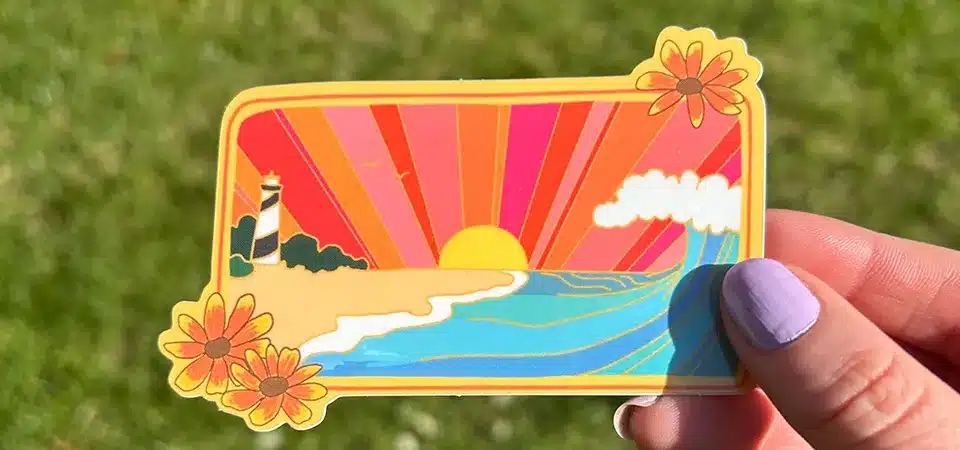
We design our premium vinyl stickers specifically for use on items like water bottles, mugs, and lunch boxes. We know they are going to get wet and need to be cleaned. The key to making them last is how you wash them.
Hand Washing vs. The Dishwasher
-
Hand Washing (Recommended): This is the best way to care for your stickered items. Use a soft sponge with regular soap and water. The vinyl and laminate create a perfect seal, so the water won't damage the sticker at all. Just be careful not to scrub directly on the sticker with an abrasive material like a scouring pad, as that can scratch the laminate over many washes.
-
The Dishwasher (Use with Caution): A dishwasher is a sticker's worst nightmare. It's a combination of high-pressure water jets, harsh chemical detergents, and extreme heat from the drying cycle. A regular waterproof sticker might survive a few cycles, but eventually, the heat will soften the adhesive and cause the edges to curl and peel. For a sticker to be truly "dishwasher safe," it needs to be made with a special high-temperature adhesive and a heavy-duty laminate. If you do use a dishwasher, always place the item on the top rack where the heat is slightly less intense.
How Long Do Waterproof Vinyl Stickers Last Outdoors?
You put a sticker on your car bumper, but it looked faded and cracked after only one season. This makes your car look old and reflects poorly on your brand or personal style.
A high-quality, weatherproof vinyl sticker with a UV-protective laminate will last 3 to 5 years outdoors. Cheaper vinyl stickers without lamination can fade and peel in as little as 6 to 12 months.

The biggest enemy of an outdoor sticker isn't water—it's the sun. The sun's ultraviolet (UV) radiation is incredibly powerful and works relentlessly to break down the color pigments in the ink. That's what causes stickers to fade.
Enemies of an Outdoor Sticker
A sticker on a car, snowboard, or outdoor sign has to fight a constant battle on multiple fronts.
| Enemy | How It Attacks the Sticker | The Best Defense |
|---|---|---|
| UV Sunlight | Breaks down ink pigments, causing colors to fade. | A UV-blocking laminate. |
| Moisture | Rain and humidity try to get under the edges, weakening the adhesive. | A strong, permanent adhesive and a sealed laminate. |
| Temperature | Extreme heat and cold cause the vinyl to expand and contract, which can lead to cracking. | High-quality, thick vinyl material. |
When a client asks for a sticker for their car, I tell them that the UV laminate isn't optional; it's essential. It acts like a powerful sunscreen for the sticker, and it's the number one factor that determines whether a sticker will last one year or five years.
Do Laminated Vinyl Stickers Last Longer?
You see "lamination" as an option when ordering stickers, but you wonder if it's just an unnecessary upsell. Skipping it could save money, but you might regret that choice later.
Yes, absolutely. Lamination dramatically increases a sticker's lifespan and durability. It adds a durable shield that protects the sticker from fading, scratches, and moisture. For any sticker that needs to last, lamination is the most important feature.
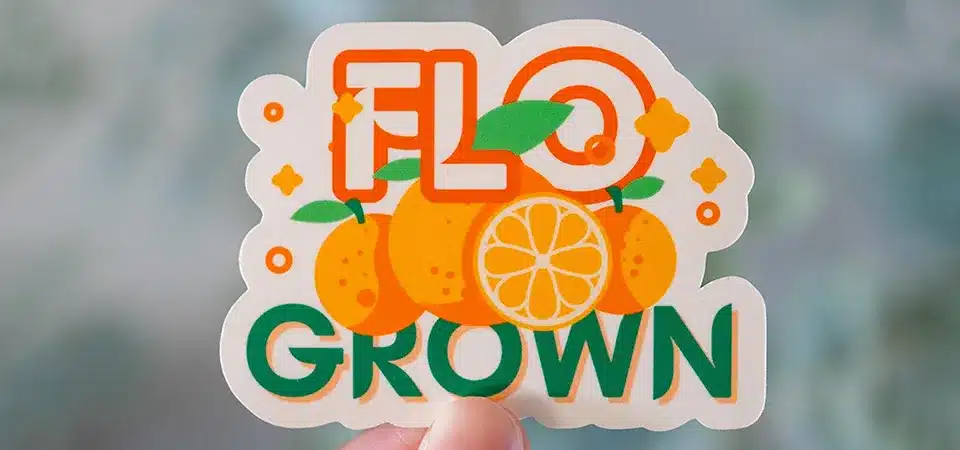
I always tell my customers to think of lamination as the clear coat on a car's paint job. The paint provides the color, but the clear coat provides the shine and protects the paint from the real world. A sticker's laminate does the exact same thing. It is a thin, transparent layer of plastic film that we apply over the top of the printed vinyl. It might not seem like much, but it's the part of the sticker that does the most work.
The Three Jobs of Lamination:
- Scratch & Abrasion Protection: The laminate takes the hit from daily wear and tear. On a water bottle, it resists scuffs. On a laptop, it protects the sticker from being scratched by zippers in a backpack.
- UV Sun Protection: A quality laminate contains special UV blockers that absorb sunlight and prevent the ink's pigments from fading. This is the key to a long outdoor life.
- Complete Waterproofing: While the ink we use is waterproof, the laminate provides a final, impenetrable seal. This guarantees that no chemicals or moisture can ever touch the printed design.
For any sticker intended for a water bottle, car, or outdoor use, I consider lamination a non-negotiable part of the process.
How to Protect Vinyl Stickers from Fading or Peeling Over Time
You got the perfect high-quality stickers, and you want to do everything you can to make them last. Small application mistakes can cut a sticker's life in half before it even starts.
Proper application is the most important step. Always apply stickers to a completely clean, dry, and smooth surface. For outdoor stickers, try to limit direct sun exposure by parking in the shade when possible.
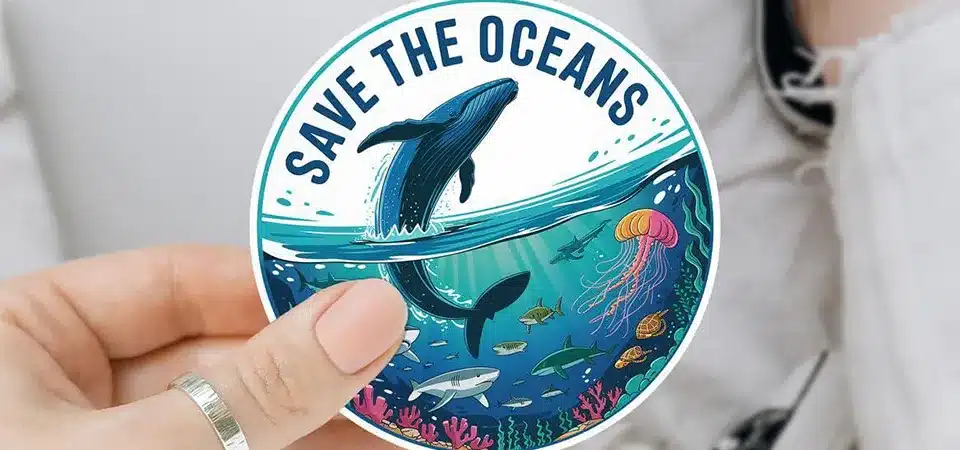
The moment of application is the most critical point in a sticker's life. A perfect sticker applied to a dirty or oily surface is guaranteed to fail. The adhesive needs a perfectly clean surface to form a strong, permanent bond.
Best Practices for Sticker Longevity
- Prep the Surface: This is the step most people skip. Before you apply the sticker, clean the surface thoroughly with a little rubbing alcohol on a lint-free cloth. This removes dust, wax, and oils that can interfere with the adhesive. Let it dry completely.
- Apply with Pressure: When you place the sticker, start from the center and smooth your way out to the edges. I use a small plastic squeegee, but a credit card works just as well. This pushes out any trapped air bubbles and ensures the entire adhesive backing makes full contact with the surface.
- Let it Cure: The adhesive needs time to set. It's best to let the sticker "cure" for 24-48 hours before exposing it to harsh conditions, like washing it or taking it through a car wash.
- Mindful Maintenance: Be gentle when cleaning. For car stickers, try not to aim a high-pressure washer directly at the edges. For stickers on water bottles, use the soft side of the sponge.
Conclusion
Vinyl itself is water-resistant, but true waterproofing requires a system: vinyl base, waterproof ink, and a protective laminate. This combination ensures your stickers will last for years, even outdoors.

